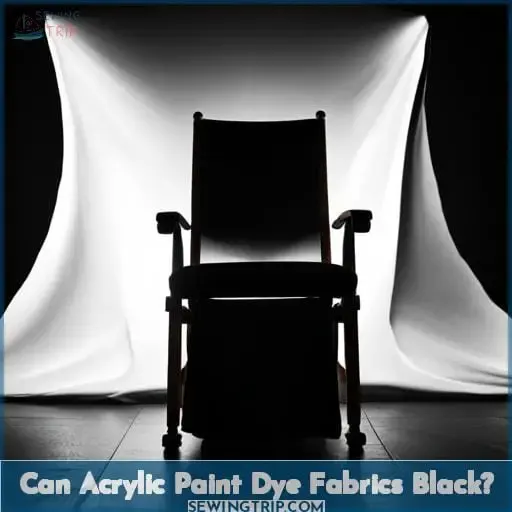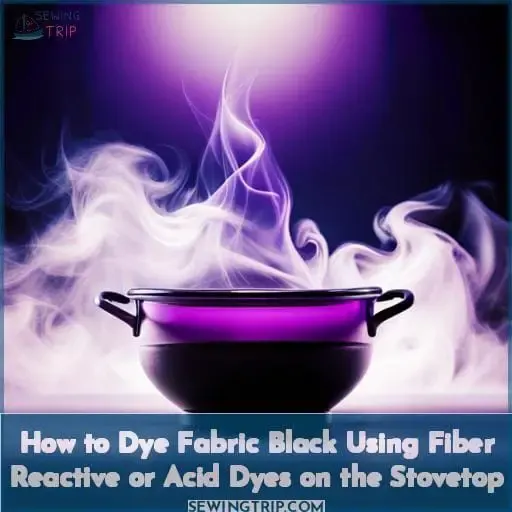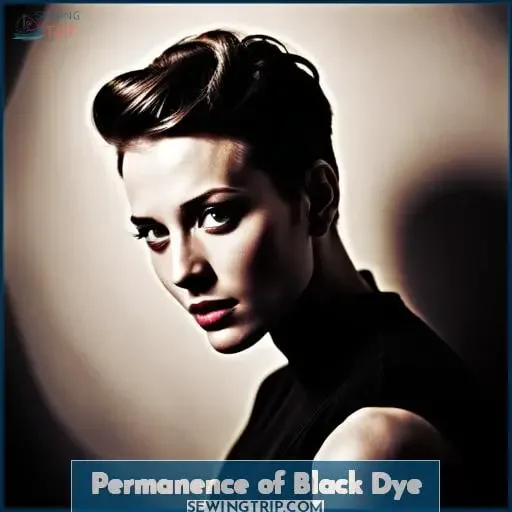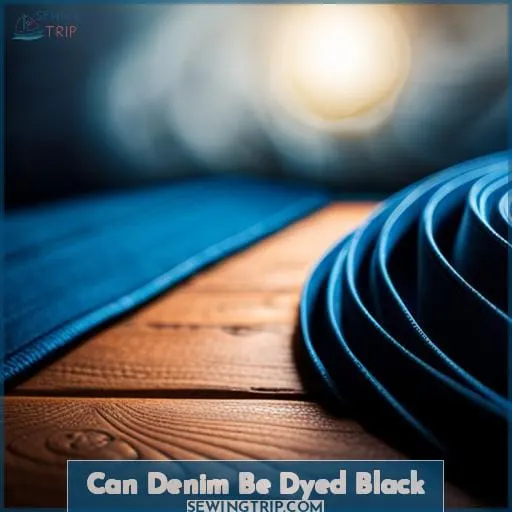This site is supported by our readers. We may earn a commission, at no cost to you, if you purchase through links.
Dyeing a shirt black is an easy way to give it a new look and style. But before you start, make sure you have the right supplies for your fabric type so that the color comes out looking great.
To help get you started, here’s an overview of how to dye fabric or clothes black, tips on permanence, and more! Whether using fiber reactive dyes or store-bought box dyes like Rit and Dylon, this guide will provide all the steps needed for achieving darker colors with success.
With just a few simple instructions – such as pre-washing fabrics in hot water beforehand – anyone can learn how to dye their shirts black with ease!
Table Of Contents
- Key Takeaways
- How to Dye Fabric or Clothes Black
- Can Acrylic Paint Dye Fabrics Black?
- Can Sharpies Dye Fabrics Black?
- Impact of Different Fibers on Dyeing
- How to Dye Fabric Black Using Fiber Reactive or Acid Dyes on the Stovetop
- How to Dye Fabric Black Using Box Dyes Like Rit and Dylon
- Permanence of Black Dye
- How to Dye Different Colored Fabrics Black
- How to Dye a Coat Black
- Can Denim Be Dyed Black
- Frequently Asked Questions (FAQs)
- Conclusion
Key Takeaways

- Different fabrics require different types of dyes.
- Pre-washing fabrics in hot water before dyeing is recommended.
- Accurately measure the fabric weight to calculate the amount of dye needed.
- Applying a fixative after dyeing helps lock in the color.
How to Dye Fabric or Clothes Black

To get that dark, rich color on your fabric or clothes that you want, it’s important to understand the type of dye and supplies needed for the job.
Bleaching black may be necessary if a light-colored fabric will not accept multiple dyes. After bleaching, choose a dye based on fiber content. For example, cotton requires fiber-reactive dyes and wool needs acid dyes.
A fixative can help set colors in place. Rit ColorStay Dye Clear is an 8oz pre-mixed concentrated liquid that works well with natural fabrics like cotton, linen, silk, or ramie.
You’ll also need gloves for protection from staining your hands when handling both wet and dry fabrics in different stages of the dying process. Disposable Medical Exam Gloves in Medium size are a perfect choice here since they offer a good grip but won’t leave residue marks after use.
If using box dye like Rit All Purpose Liquid Dye, then double the amount should be added to the water bath along with salt and dish soap before submerging the damp garment into the solution at a specific temperature.
Stir every 5 minutes until the desired shade is achieved – usually around 40 minutes total time depending on how deep black one wants the dress to appear. Once rinsed off and washed separately from other items (cold water cycle), hang it up to dry naturally away from direct sunlight exposure.
Finally, don’t forget to add an extra bit of safety layer by applying ColorStay Dye Fixative lastly. It acts as a barrier against fading over time due to its unique formula designed specifically for this purpose.
Can Acrylic Paint Dye Fabrics Black?
No, acrylic paint is not suitable for dyeing fabrics black as it results in a stiff coating that can easily chip off. The best way to achieve an even solid black on any fabric type is by using dyes specifically designed for the purpose.
Depending on the fiber content of your garment, you’ll need different types of dyes. Cotton requires fiber-reactive dyes, while wool needs acid ones. Moreover, blended fabrics may require separate baths so that all fibers are penetrated with dye evenly and completely.
Box dyes like Rit or Dylon could also be used, but specialized ones tend to offer more consistent results overall when dealing with deep dark colors such as blacks and blues.
Once dyed, rinsing and washing afterward remove excess pigments left behind. It is important to stir frequently throughout each step, allowing colors enough time to absorb properly into cloth fibers. This ensures the desired intensity is achieved without fading away over time. However, adding a fixative specially formulated towards this end will help lock in hues further, particularly if going through machine washes regularly afterward.
This is important as slight bleaching might otherwise occur naturally, eventually dulling out the shade’s original radiance somewhat prematurely.
Can Sharpies Dye Fabrics Black?
You can use Sharpies to add some black accents to smaller fabric pieces, but they are not suitable for dyeing large areas. While it may seem like a quick and easy solution, the color tends to fade quickly due to the lack of any real fiber penetration.
This is why multiple dyes or a cup of liquid dye should be used for larger sections instead in order to achieve greater depth and permanence in color.
It’s important when selecting fabrics that you choose ones with all-natural fibers such as cotton, linen, wool, or silk. These fabrics will accept both fiber-reactive dyes and an acid-based option if protein fibers are present.
This allows for deep, rich hues that won’t fade easily over time. Using a fixative specifically formulated for this purpose helps lock in colors, especially when going through regular machine washes afterwards.
This ensures that slight bleaching does not naturally occur, dulling out the shade’s radiance prematurely.
Dye methods also depend on personal preference. However, there are advantages and disadvantages associated with each one, depending on the desired outcome. Reviving faded black clothes can be done using Rit All Purpose Liquid Dye or ColorStay Dye Fixative, which are among the top choices available today (with links provided).
It’s always best practice to pre-wash items before starting any project involving fabric dyeing processes like these. Additionally, record their weights accurately so that accurate measurements can be made later during the mixing steps.
Impact of Different Fibers on Dyeing
Understanding the fiber content of fabrics you want to dye is essential for achieving consistent results, as different fibers require separate dyes and processes. This includes plant-based fibers like cotton that need fiber-reactive dyes, while protein fibers such as wool call for acid dyes instead.
Blended fabrics may also need separate baths in order to penetrate each individual material thoroughly.
Here’s a list outlining these requirements:
- Plant Fibers – Fiber Reactive Dye
- Protein Fibers – Acid Dye
- Blended Fabrics – Separate Baths per Fiber Type
Boxed fabric dyes like Rit and Dylon are generally accessible, but specialized options can yield more successful outcomes when compared side by side with them.
Allowing fabric enough time to absorb color fully will ensure deep hues from start right through finish, while rinses afterwards help rid excess dye residue still lingering within the piece itself further still.
Ultimately, though, what type of best fabric dye more people decide upon depends heavily upon their own personal preferences really since all methods themselves come packed with advantages & disadvantages alike anyway overall! Nevertheless, no matter whatever route chosen ultimately there’s one thing that remains certain regardless: quality materials combined alongside clever crafters always make up exquisite artistry every single time without fail all round indeed y’all – why not pin tips shared today onto your Pinterest boards then & see just how far you’ll go next?
How to Dye Fabric Black Using Fiber Reactive or Acid Dyes on the Stovetop
If you’re looking to dye fabric black, it’s essential to make sure you have the right supplies on hand. Before getting started, pre-wash and dry the fabric or garment, then record its weight – this will be used to calculate how much dye is needed for your project.
Supplies
Gathering the right supplies for dyeing black fabric is essential, so stock up on a non-toxic powder dye like Rit’s 2-Pack, plus ColorStay Dye Fixative, and some disposable gloves.
Preparing fabrics properly before use with prewashing and recording weight are key steps to ensure vibrant colors that won’t fade!
Get the perfect ratio of box dyes or a bottle of dye by calculating the amount based on fabric weight.
For deeper hues, double dyeing may be needed; then fix in the color with hot water baths & cold rinses afterwards.
With these tips in mind, you’ll have your dream black clothes dyed from the choice of synthetic blend to pure cotton using Rit Dye confidently!
Pre-wash and Dry Fabric or Garment
Before dyeing, it’s important to pre-wash and dry your fabric or garment. This removes dirt and oils that could interfere with the process. Calculate how much dye you’ll need by weighing the fabric. Start with a large pot of hot water for one of the hardest dyeing projects – a black shirt! Mix in cups of hot tap water, salt, and detergent before submerging the item in it for colorfast results.
Rinse thereafter, then machine wash using the cold setting; this helps set the color too! With these tips, you can easily use Rit Dye to create a unique look without hassle or messiness.
Record the Weight of the Dry Item
Record the weight of your dry item before dyeing to ensure an appropriate amount of dye is used for reliable results. Pre-wash and note the fabric weight as essential steps for creating a white item jet black.
Calculate how much dye you need based on fiber content and fabric weight. Then, mix the solution with hot water in a pot or sink according to package instructions. Avoid using acrylic paint as it creates a stiff coating that easily chips off. Specialized dyes should be used instead of Rit Dye, as a bottle of liquid may not yield consistent results.
Consider using ColorStay Dye Fixative to revive faded clothing. Its special formula sets color beautifully without fading over time.
Calculate Amount of Dye Needed
To get the perfect black hue, calculate how much dye you’ll need based on your fabric’s fiber content and weight. Use a bamboo skewer to measure color matching for fabrics like cotton or linen that require fiber-reactive dyes.
For protein fibers such as wool, use acid dyes and record fabric weight before pre-washing it. Make sure to add dye fixative after dyeing in a large pot of water at a specific temperature – this helps set the color perfectly! Afterwards, rinse with cold water until all excess dye is removed.
Then, wash with Purpose Rit Dye for the best results when trying to dye a shirt black.
Mix the Dye
Mix the perfect black dye solution with your fabric content and weight in mind to stir up a truly custom color. Different fabrics require different dyes, so make sure to choose the right one for polyester blends or bright red dresses.
For safety reasons, it’s important not to mix different dyes. Color fixing after dyeing helps set the hue perfectly! Frequent fabric dyers may revive faded black items too – just remember that pre-washing is essential before you begin this process.
How to Dye Fabric Black Using Box Dyes Like Rit and Dylon
Are you looking to dye a shirt black? To achieve the best results, start by pre-washing and drying the garment or fabric. Then, calculate the amount of dye needed based on its weight. Finally, add it to a dye pot with water and mix in both a dye activator and a packet of colorant.
Pre-wash & Dry the Garment or Fabric
Before beginning any dyeing project, it’s important to pre-wash and dry your garment or fabric for the best possible results.
You’ll also need handling gloves, dye fixative, and an exact measurement of both dye amount according to the weight of your dry item, as well as a precise temperature for mixing with water. This is especially vital for fabrics like cotton, which require fiber-reactive dyes.
For blended fabrics, make sure all fibers are penetrated during separate baths so that nothing goes awry when washing afterwards.
With these steps taken care of beforehand, how to dye a shirt black will be smooth sailing from here on out!
Calculate Amount of Dye Needed
Once you’ve pre-washed and dried your garment or fabric, make sure to accurately calculate the amount of dye needed based on its weight. This will depend on the type of dye used. For plant fibers like cotton, you’ll need fiber-reactive dyes, while bamboo requires acid dyes.
The amount of water in your dye pot will also affect the calculation. To achieve a deep color, it’s often recommended to add twice as much time as suggested for box dyes like Rit and Dylon. After dyeing, you can enhance color retention by giving your fabric a hot water bath with a generous amount of ColorStay Dye Fixative.
This will help set the colors better and remove any excess dye that may have rinsed off.
Add Item and Water to the Dye Pot
After calculating the amount of dye needed, add your item and water to the pot. Stirring is essential for deep color penetration. Make sure you pre-wash and record fabric weight beforehand; this will help determine how much dye to use and how many cups or gallons of water are needed in the dye pot.
ColorStay Dye Fixative can be used after rinsing off excess dye to set colors more securely – it’s one of the best methods available! But no matter what you do, remember that the single most important thing is to stir frequently throughout the process! This ensures even coverage so every inch gets saturated with color for beautiful results each time.
Add Dye Activator and Dye Packet
Next, dissolve the dye activator in hot water and add the dye packet to create your customized color.
When working on one of the hardest dyeing projects, like black clothing, it’s essential to get all the details right. This includes pre-washing and recording the fabric weight correctly for an accurate ratio of activator and temperature control when adding dyes.
Achieving permanent results requires using a professional-quality fixative after rinsing off excess color from your favorite pair of jeans or shirt.
Dyeing projects are made easier by following these key steps: activator ratio, correct temperature setting for each type of dying material (cotton/wool, etc.), and calculating the exact amount based on fabric weight before beginning the project.
Stir Frequently Until Dye is Absorbed
Stir constantly as you watch your fabric slowly absorb the dye, creating a deep and vibrant black color. Calculating the exact dye amount based on pre-washing and recording fabric weight is essential for success.
Once in the dyepot at an appropriate temperature, keep stirring until all of it has been absorbed. This may take longer with large pieces of fabric than small ones due to different rates of absorption.
Consider separate baths if blending fabrics are involved to ensure each one gets penetrated properly.
Permanence of Black Dye
To make sure your black dyed garment lasts, it’s important to use a dye fixative and wash the piece in cold water after rinsing. When calculating dye amounts, be sure to factor in fabric weight for accurate results.
The temperature of the dye pot should also be considered, as different dyes require different temperatures for optimal color absorption. Rit All Purpose Liquid Dye is suitable for natural fabrics like cotton, linen, wool, and silk, while ColorStay Dye Fixative can help set colors that have been added with other types of dyes, such as fiber reactive or acid ones.
Additionally, you could try more unique methods like tie-dying or ice dying, which will give interesting effects when used on garments made from polyester material or porcelain surfaces, such as sink basins and serving trays!
DIY resin projects are another fun craft project that you can explore if you want something a little out of the ordinary that still looks amazing! With all these options available, there’s no limit to what kind of creative look you can come up with, so don’t hesitate to experiment until you find just what works best for your particular project goals!
How to Dye Different Colored Fabrics Black
When dyeing different colored fabrics black, it’s important to consider the fabric type and fiber content for successful results. Natural fibers like cotton, linen, wool, or silk are best suited for Rit All Purpose Liquid Dye.
When using a dye pot on the stovetop with natural fibers, half of the amount of water should be replaced with vinegar or salt to help set colors better. For protein-based fabrics such as wool or cashmere, acid dyes are often recommended because they penetrate deeper into these types of materials than other types of dyes do.
For those who don’t have access to specialized supplies at home but still want great results when reviving work dresses from favorite places like Boden (known for quality machine washable clothes), box dye is usually a good option.
Just remember that you’ll need double the amount and extended dye time compared to normal instructions! Additionally, it’s always wise to use ColorStay Dye Fixative after rinsing off excess solution in order to save your precious garment from fading over time.
No matter what method you choose when dyeing your garments black, there will likely be an element of trial-and-error involved before finding exactly what works best according to personal preference and desired outcome.
If nothing else, though, rest assured knowing that any attempt made towards reviving faded clothing is a sure step closer to liberation, power, and mastery over life’s fashion projects.
How to Dye a Coat Black
Dyeing a coat black requires specific supplies and steps, so why not take the plunge and give your wardrobe an upgrade with this fun DIY project? To make sure you get the best results when dyeing your coat, it’s important to consider factors like fabric content, fiber type, dye pot temperature, as well as the amounts of dye used.
For natural fibers such as cotton or wool, look for dyes specially formulated for those materials. Rit All Purpose Liquid Dye is a great choice here! If you’re dealing with hard-to-dye colors like blues or greens, then try using a blended box mix instead, which can help provide more consistent coverage.
For fabrics that have bleach stains on them, pre-treat them prior to dyeing by soaking in a vinegar solution overnight before proceeding.
Once all preparations are complete, set up your first dye bath following the instructions on the package carefully. Always keep in mind that the amount of water should be twice the weight of the garment being dyed, if possible.
When ready, add salt plus the desired amount of powder/liquid colorant into hot water at the recommended temperature, stirring until dispersed evenly throughout the liquid before submerging the item(s).
Lastly, once finished, don’t forget about the final rinse step using cold running tap water, followed by a washing machine cycle only with dark clothing! Finally, create an eye-catching statement piece from an old jacket after adding some extra decorative accessories like buttons or beads.
Even better, use an upcycled tea tin planter for a lovely plant display indoors too! With a bit of preparation beforehand, there’s nothing stopping you from achieving an amazing black color transformation anytime soon.
Can Denim Be Dyed Black
Giving your denim a black makeover is easier than you think! Whether it’s for an instant wardrobe refresh or to create a one-of-a-kind piece, dyeing denim black can be both satisfying and rewarding.
But before tackling this quick project, there are some important things to consider, like the fiber content of your fabric. Different fibers require different dyes, so if you’re using jeans with blended fabrics, then separate baths may be necessary for all fibers to penetrate deep into the material.
For natural fabrics such as cotton and wool, Rit All Purpose Liquid Dye in Black works best, but box dyes like Rit or Dylon can also do the job – just note that these tend to recommend double the amount and extended time when dyeing dark colors like black.
Once everything’s sorted out, set up two large pots filled with hot water on the stovetop, at least twice as much water as the garment weight, plus salt for deeper color penetration. Add 2 ounces of powder/liquid dye concentrate per 1 gallon of liquid, depending on the desired depth shade.
Follow stirring instructions carefully every few minutes during each 10-minute period until the desired saturation is achieved. Pour off the excess after the last cycle is complete, followed by a thorough rinsing process while still wearing gloves until the water runs clear from the tap (do not use detergents!).
If needed, opt to add ColorStay Dye Fixative solution instead of dishwashing soap during the second bath, which helps set the color longer over time when machine washing later too!
While dyeing clothing may seem intimidating at first glance – especially if the goal is achieving jet-black hues – doing research beforehand makes the whole process go smoother, saving precious resources along the way.
Frequently Asked Questions (FAQs)
What type of clothing is best suited for dyeing black?
Dyeing black is a great way to breathe life into an old piece of clothing. The best fabrics for dyeing are natural fibers like cotton, linen, wool, and silk; they’ll absorb the color better than synthetics.
How long should the fabric be left in the dye bath?
Dye your fabric for a duration that will bring out its desired hue; immerse it in the dye bath and stir periodically, enabling it to fully absorb the color.
Is it necessary to use a dye fixative?
Using a dye fixative is recommended for best results as it helps set the color and reduce bleeding and fading. It’s an easy way to ensure your fabric looks great after using dyes – plus, you’ll get more consistent results! So don’t forget the fixative when reviving faded black clothes – it can make all the difference in achieving vibrant colors.
Can the same dyeing process be used for faded black clothes?
Yes! The same process of dyeing with Rit All-Purpose Liquid Dye and ColorStay Dye Fixative can be used to revive faded black clothes.
Is it possible to dye denim black?
Yes, it is possible to dye denim black. With the correct supplies and techniques, you can revive faded or dull jeans with a deep shade of black that will endure for years. Select a suitable dye according to the fabric type and carefully follow the instructions to achieve uniform coverage and long-lasting outcomes.
Conclusion
Ready to bring your faded black clothes back to life? With the right supplies and steps, dyeing fabric black is a great way to revive the look and color of your favorite pieces. Have you ever tried dyeing black? It can be a lot of fun, and you might be surprised by the results.
So why not give it a try and see what happens? You could end up with a wardrobe full of vibrant new black pieces.















